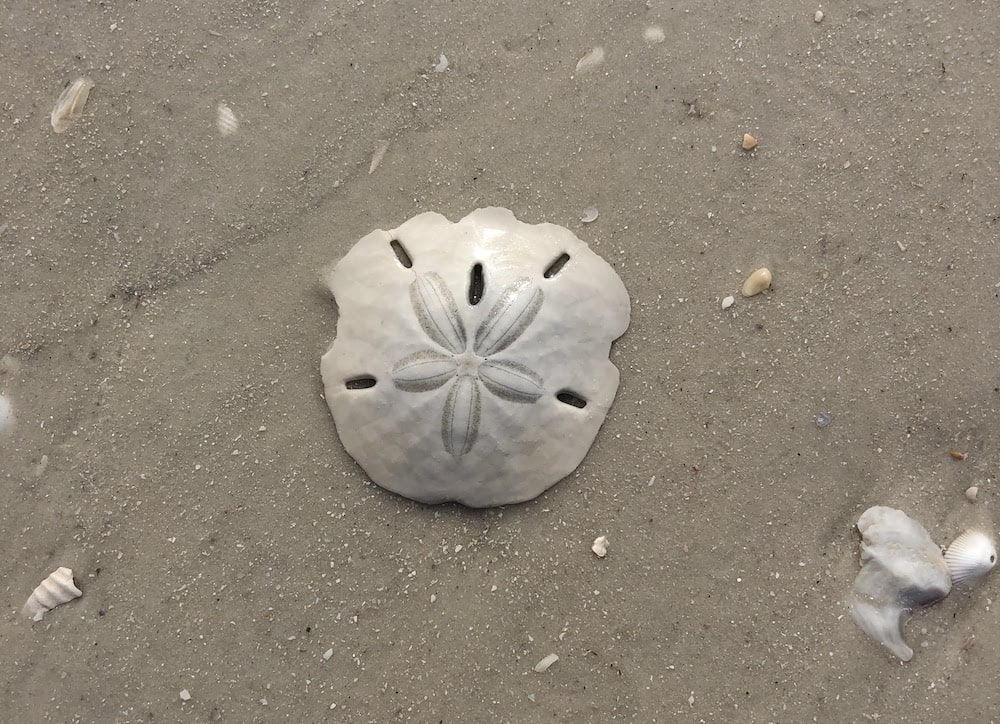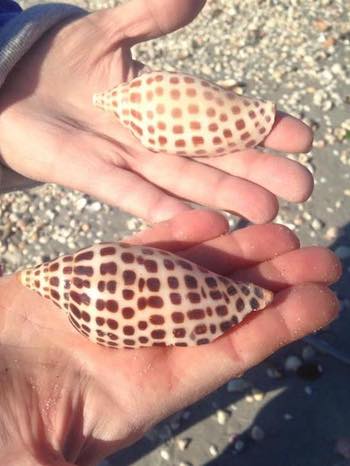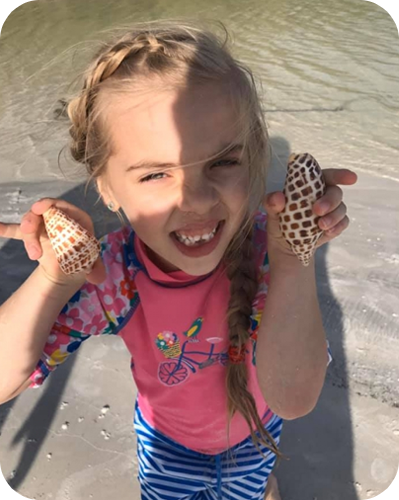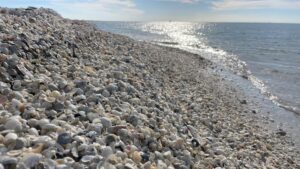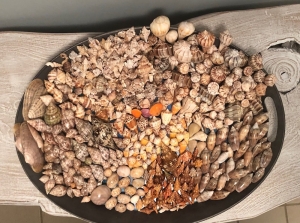When you picture a sand dollar, do you envision the pristine white star-stamped disk that can be bought in souvenir shops and sometimes (if you are lucky) found along the beaches?
Have you ever wondered what is a sand dollar? The truth is that the sand dollar, when alive, looks nothing like the popular white disc that most people envision.
Live sand dollars are purple (or sometimes red or brown) and “hairy” (actually flexible bristles called “spines”) and live along the ocean floor.
There is a myriad of fun facts to learn about the sand dollar. Keep reading to learn about what is inside a sand dollar, what type of animal they are, the history of the sand dollar, and more!
What Does a Sand Dollar Look Like?
A dried and dead sand dollar is bleached white, the hard exoskeleton is smooth, with a star or flower-shaped pattern on its back.
Most specimens will have five openings symmetrically placed around the body (some smaller specimens may not have these).
Living sand dollars look very different from this. They tend to run from reddish-brown to deep purple in color and are covered in flexible cilia. They have pores on their back and an opening underneath that is the mouth.
The Living Sand Dollar
The sand dollar is part of the Echinoidea class and the Phylum Echinodermata. There are eleven different species of sand dollars and they are found in waters including in the Pacific, Caribbean, and Atlantic oceans.
Sand dollars are related to sea stars and sea urchins. These creatures are bottom-dwellers that feed on microscopic algae and bacteria on the ocean’s floor.
They have an average lifespan of about ten years and play an important part in the marine ecosystem.
As stated above, when alive, the sand dollar isn’t white but ranges from a deep reddish to purple color. They are also covered in spines, that are flexible and give them a hairy look.
Sand dollars use these spines for eating. The tiny hair-like cilia push food particles from the ocean’s floor along their bodies to their mouth located in the center of their body.
Sand dollars do not have a brain, but a “nerve ring” that regulates its body functions.
Sand dollars tend to live in crowded areas, often with as many as 625 in one square yard.
This close proximity aids in reproduction, which is down by “swapping,” meaning that the females release eggs and the males release sperms into the water column. Fertilized eggs hatch into new sand dollar larvae.
Non-fish predators include crabs and seagulls. Gulls are actually one of the more prominent predators of sand dollars, as they carry them in their mouths and break them open on rocks to eat the insides.
The Sand Dollar Skeleton
The sand dollar skeleton, sometimes also referred to as the sand dollar fossil, or test (a test is a skeleton of an urchin) is the hard shell that is left after the sand dollar dies and dries out.
A complete and intact sand dollar fossil is a coveted prize among many beachcombers.
The sand dollar exoskeleton is made of calcium carbonate. This is what gives it a white appearance after it has dried out.
The star-shaped (or sometimes referred to as a flower-shaped) marking on the surface of the sand dollar is one of the reasons that many collect them.
These markings actually mirror the sand dollar’s internal structure and are also pores that allow the exchange of sea-water containing dissolved gases and nutrients through the sand dollar’s hard covering.
What Is Inside a Sand Dollar?
If you have ever shaken a sand dollar fossil, you might have heard a slight rattling noise.
That sound is the dried-up eating apparatus of the sand dollar. Inside the sand dollar is a jaw that has five teeth-like sections, 50 calcified skeletal elements, and sixty muscles.
The inside of the sand dollar is also where the nerve ring and reproductive organs are stored. Once the sand dollar dies, these parts dry out, leaving only the skeletal remains of the eating apparatus.
BOOK YOUR SHELLING TOUR!
Are You Looking For A Guided Seashell Finding Tour in Southwest Florida? Book With Sand Dollar Shelling!
Sand Dollars and the Ecosystem
Live sand dollars are an important player in the marine ecosystem. In the food chain, they help control the population of smaller invertebrates and are food for a few larger organisms.
Because sand dollars have a hard exoskeleton and not many edible parts, there are not a lot of natural predators to it.
However, there are a few species that will take the time to break open a sand dollar to eat it including some fish (flounder, sheepshead, haddock, and cod). Crabs and seagulls are also natural predators of the sand dollar.
When sand dollars burrow into the sand, they provide more oxygen at lower levels of the ocean floor. This allows for more organisms to live and thrive in that environment, creating greater biodiversity.
Threats to the sand dollar include fishing (most especially bottom trawling fishing), and changes in their environment due to pollution and climate change.
Ocean acidification and reduced salinity levels adversely affect the reproduction cycle of the sand dollar.
Renting a boat to travel to some of the more secluded areas in Flordia is one of the best ways to see sand dollars in their natural habitat.
A Sand Dollar by Any Other Name
Sand dollars are named as such not for their monetary value, but because of their appearance.
The white, bleached-out sand dollar skeletons were thought to resemble old American and Spanish dollar coins, and thus the name was born.
Other names for the sand dollar include sand cakes, pansy shells, snapper biscuits, cake urchins, and sea cookies.
How Much Is a Sand Dollar Worth?
Because sand dollars are so prolific, they are very common. The cost of a live sand dollar for an aquarium might run between five and fifteen dollars.
You can pick up a sand dollar skeleton at many local beach souvenir shops from anywhere from a dollar to five dollars. The size is usually the determining factor in the price.
The larger the sand dollar, the more expensive it will be.
However, no price can be put on the experience of finding your own sand dollar. Consider a Sand Dollar Shelling tour for you and your family to experience collecting your very own sand dollars on pristine beaches.
The Legend of the Sand Dollar and Other Folklore
There are several legends and folklore tales surrounding the sand dollar.
Perhaps one of the best known is the “Legend of the Sand Dollar” which was penned by a screenwriter named Chris Auer.
Using Christian symbolism, this legend equates the five slits in the sand dollar as representing the wounds on Christ and the star in the middle as a representation of the star of Bethlehem.
The back outline is likened to a poinsettia, and when the sand dollar is broken open, the five jaw apparatuses are said to look like doves, and that they release goodwill and peace in the world.
A non-Christian-based folklore tale of the sand dollar is a mythological legend that sand dollars represent coins that were lost by mermaids. Another is that they are coins of the people of the mythical city of Atlantis.
The sand dollar’s mouth is called Aristotle’s lantern, named so by the Greek philosopher because of its resemblance to a horn lantern.
Collecting Sand Dollars
A lot of visitors to beaches like to look for a sand dollar of their own to take home as a souvenir.
The best time to look for sand dollars is a low tide. Walk along the area near the high-tide line and look for round patches or what looks like depressions in the sand.
When you find a sand dollar, make sure it isn’t alive before you take it. In many states, it is illegal to take a living sand dollar. Here are three things to look for to determine if the sand dollar is dead or alive:
If the sand dollar is still covered in spines, place it in your hand and observe them. If the spines are moving at all, the sand dollar is alive.
(But sure to do this gently and with caution, the spines can cause puncture wounds that can become infected.)
If the sand dollar isn’t white but is brown, red, or purple, it is still alive.
Finally, if the sand dollar leaves a yellow stain on your skin, it is releasing a substance called echinochrome. That means it is alive.
If the sand dollar you find is alive, place it gently back into the water. Sand dollars cannot survive long out of the water, and placing them back into the sea will allow them to live and continue to be part of the ecosystem.
One of the best ways to collect sand dollars is to book a shelling tour with a trusted professional guide. Our Marco Island shelling tours allow you to collect shells in some of the most secluded islands in Southwest Florida.
Preserving Sand Dollars
After harvesting a dead sand dollar from the beach, you can clean and preserve it by soaking it in freshwater, and changing it out until it doesn’t discolor the water, then air-drying on a towel or other absorbent surface.
A bleach/water solution (around three parts water to one part bleach) can be used to help whiten the sand dollar, but care should be taken to leave it in the solution for only a few minutes as bleach can dissolve the sand dollar.
Finally, if you want to ensure your sand dollar stands the test of time, you can paint it with a one-to-one mixture of water and Elmer’s white glue.
Lay the sand dollar on wax paper while applying the mixture to keep it from sticking to any surfaces and paint the mixture on with a paintbrush. This will seal the sand dollar from dirt, dust, and the elements.
More Random Sand Dollar Facts
As you can see, the sand dollar has a lot more going on than just its pretty appearance. Here are a few more random facts about the sand dollar:
You can tell the age of a sand dollar by looking at the number of rings on the bottom of its shell (just like measuring the age of a tree by its rings).
There are dozens of different varieties of sand dollars, depending on what part of the world you find them.
Sometimes young sand dollars are too light to anchor themselves against the powerful ocean currents, so they will eat sand to add weight.
It can take a sand dollar up to two full days to digest the food they consume.
Sand dollars move by pumping water through their pores (the “flower petal” pattern on the top of the exoskeleton are the sand dollars’ pores). As water and gas get pushed through the pores, it propels the sand dollar forward.
Sand dollars often stand on one end in still and calm waters but will lie flat or even burrow under the sand when the water gets choppy or rough.
A Fascinating Sea Creature
As both a living part of a thriving marine ecosystem and as a coveted souvenir from beach trips, the sand dollar is a fascinating sea creature.
After learning about what is inside a sand dollar, it is even easier to appreciate its outward beauty.
When visiting the Southwest Florida area, be sure to contact us for your chance to collect your very own sand dollars, along with many other beautiful and interesting seashells.
Our tours allow visitors to collect shells from some of the most pristine islands in the area.

